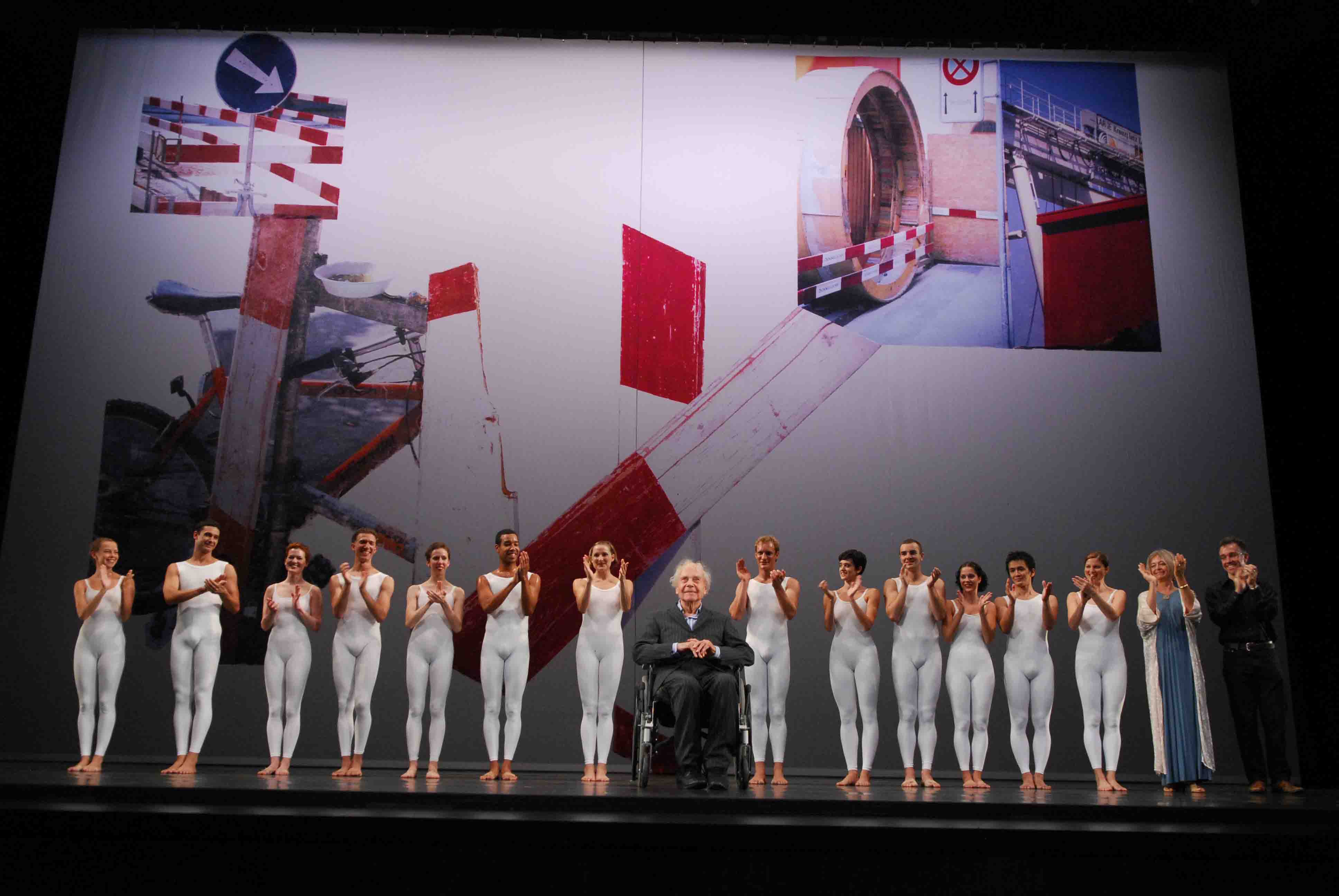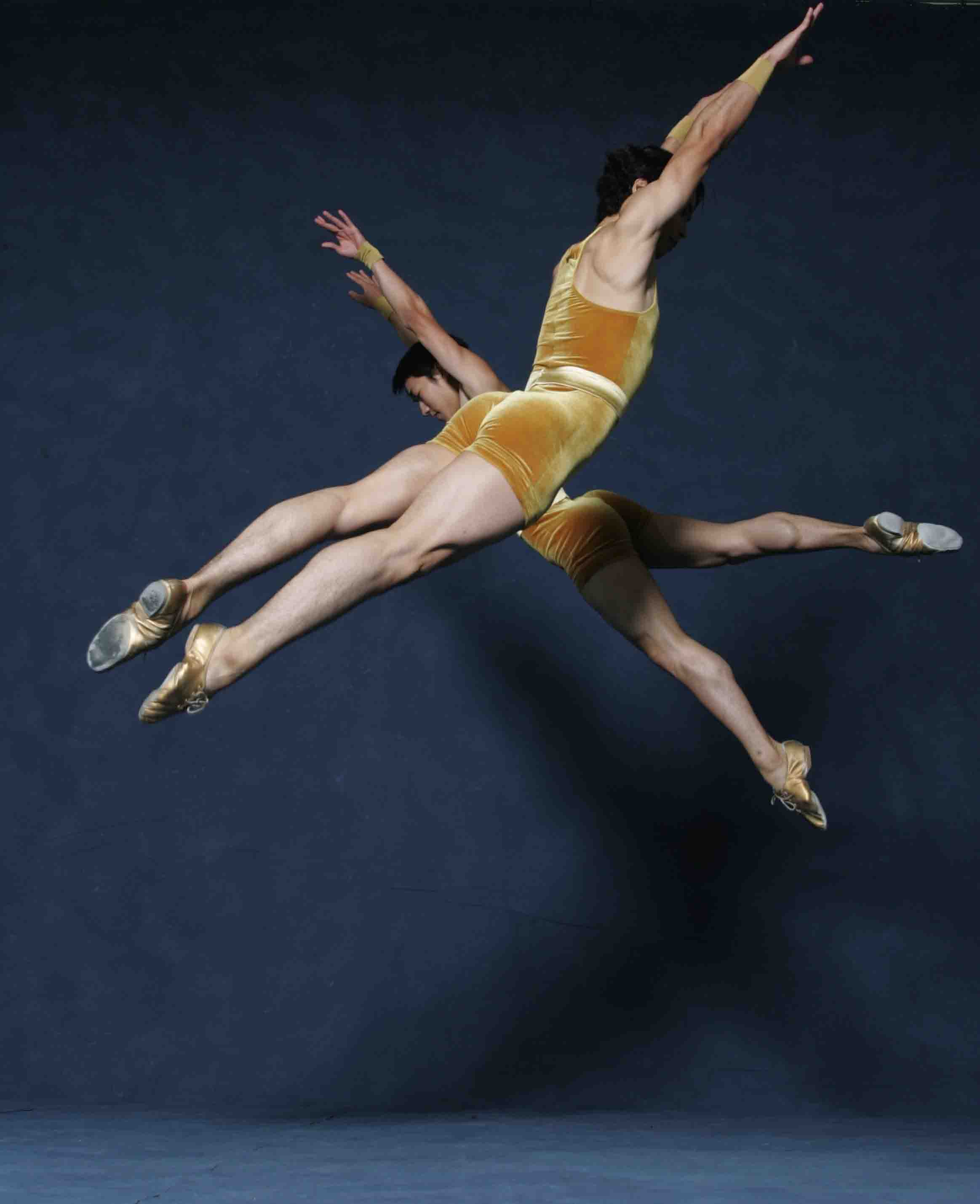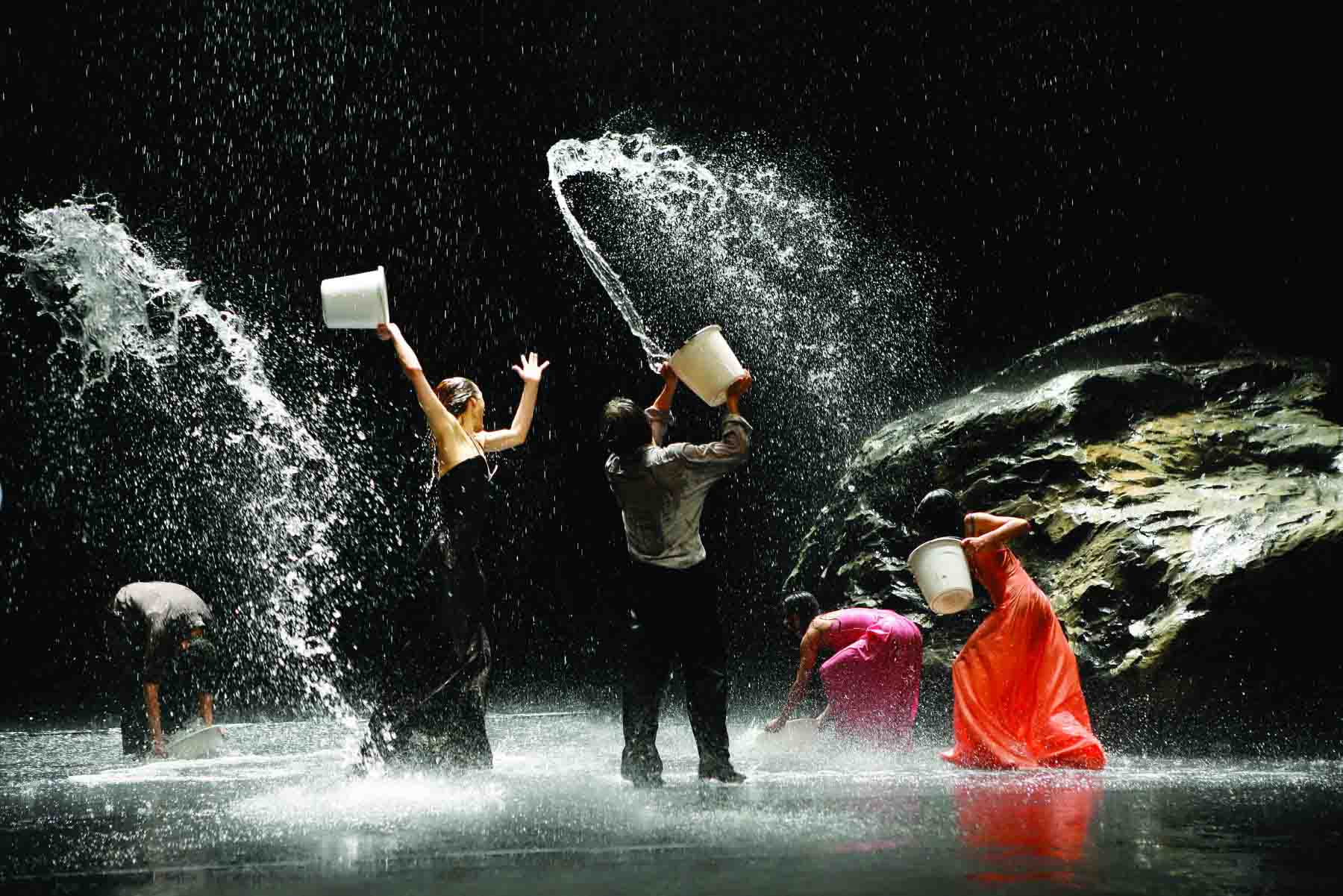Counter Space: Design and the Modern Kitchen / Museum of Modern Art, NYC / September 15, 2010 – March 14, 2011
Fall for Dance / City Center, NYC / September 28 – October 9, 2010
Tanztheater Wuppertal Pina Bausch / BAM Howard Gilman Opera House, Brooklyn, NY / September 29 – October 9, 2010
Trisha Brown Dance Company / Whitney Museum of American Art, NYC / September 30 – October 3, 2010
Every now and then I steal time from dance, my regular beat, to indulge another passion: old things–vintage fashion, vintage films, vintage photography, and, yes, even vintage housewares. So of course I scurried over to the Museum of Modern Art to ogle Counter Space: Design and the Modern Kitchen. It’s at once a charming and sociopolitically resonant exhibition–the latter because, if you wanted to study the role assigned to Woman, where, until the last half-century, would you have been likeliest to find her?

Woman’s Workplace: Margrette Shütte-Lihotzky’s “Frankfurt Kitchen” in the Museum of Modern Art’s Counter Space: Design and the Modern Kitchen
The centerpiece of the show is a real room–the “Frankfurt Kitchen,” designed for public housing in 1926-27 by Margrette Schütte-Lihotzky. Not an inch of space is wasted here; austere form follows practical function without once succumbing to the adornment or idiosyncrasy that would indicate human life. Nearly all the storage space is painstakingly compartmentalized, its contents hidden but ready to hand. Peering into this room, you imagine you could stand at its center with at least one foot fused to the floor and prepare a multi-course dinner (for agoraphobics it would be paradise).
Seconding this a-place-for-everything-and-everything-in-its-place example is a late 1960s mini-kitchen cannily devised as a series of hinged rectangles. Unfurled, it reveals dedicated storage spaces; closed, it becomes a pair of hygienic-white boxes. Both kitchens pay homage to the gods of ever-increasing efficiency and, ostensibly, progress.
Second in importance only to the kitchens themselves are the handsome tools of the culinary trade, lined up in capacious vitrines. Lots of these objects will be recognizable to the comfortably-off as part of their own batterie de cuisine or that of their mother or grandmother. Most of them, sleek as Brancusi sculpture, are clearly striving to be works of art–sometimes, as I know from personal experience, at the expense of functionality.
Much as I admired the damned good design of all these things, I was gradually depressed by the pervasive sterility. When the person with whom I share a kitchen cooks, the room ends up looking like Berlin after World War II. Where, I wondered (granted, inappropriately), is the mess often associated with action–and thus with life itself? Should we cling to the Bauhaus tenet of “less is more” when chaotic abundance offers so much vitality? Ironically, chaotic abundance abounded, one way or another, in the dance events I saw in the two weeks that followed my MOMA fling.
Fall for Dance, in its seventh season at New York City Center, intentionally offers everything but the kitchen sink. It’s designed to attract newcomers to Terpsichore’s Wonderland, enticing them with $10 tickets to any of the 2100 seats in the house and then giving them four items on each program that are as disparate as dance can get, so the spectator is pretty sure of finding at least one item to fire his imagination. This season–completely sold out a week before the series started–comprises five programs, each being performed twice.
Opening night began boldly with Merce Cunningham’s complex, abstract Xover (pronounced “crossover”), perhaps the least accessible and most sophisticated work in the whole run. Danced before a backdrop by Robert Rauschenberg and accompanied by two John Cage scores (performed simultaneously), the movement is one of Cunningham’s most exquisite exercises in purity.

Maestro: Merce Cunningham flanked by the dancers of his Xover
Photo: Kawakahi Amina
Minimally dressed in white practice clothes, 14 ultra-svelte dancers execute non-narrative, (ostensibly) non-expressive movement that reveals dance pared down to its essence–razor-sharp lines, lyrical curves, delicately shifting balances, and human ardor seeking ecstasy. Its centerpiece is a 7 ½ -minute duet (an eternity in dance time) for a male-female couple in which each partner calmly, delicately, and inventively responds to or supports the other’s smallest shift in position or location in space. Like Frederick Ashton’s Monotones, it’s a vision of Heaven.
Cunningham’s company, nearing the midpoint of a two-year world tour following the choreographer’s death, after which it will disband–all this according to the late master’s instruction–danced, the way all dancers should, as if this performance were their last: fully committed, aware that every living thing dies, and rejoicing in the moment.
This was a tough act to follow. Miami City Ballet, which stunned the New York audience with its vitality on its last visit, couldn’t throw caution to the winds as the virtuoso feats and rakish rhythms of Twyla Tharp’s The Golden Section demand. This is a company that has already given thrilling accounts of Tharp’s In the Upper Room and the daring Rubies section of Balanchine’s Jewels. A puzzlement, as Yul Brynner liked to say when he was the King of Siam.

Cross-purposes: Miami City Ballet dancers in Twyla Tharp’s Golden Section
Photo: Joe Gato
The seasoned Odissi dancer Mudhavi Mudgal and her four young acolytes breathtakingly turned rouged wrist, palm, and fingers into luscious blooming flowers, but Mudgal’s choreography, dependent upon the most banal conventions of Western dance structure, stymied any possibility of transcendence.
The rocket rise to recognition of Gallim Dance utterly escapes me. I Can See Myself in Your Pupil, choreographed (I use the word generously) by the troupe’s founder-successor, Andrea Miller, manages to be both unattractive and uninteresting. It mashes together street dance bled of its freshness, gymnastics, acrobatics, and a pervasive yet unexplained hostility between the sexes. (The girls win.) It has no notion of relating to the space it inhabits, the crudest response to music, and an incredible lack of intelligence. No doubt unintentionally, it tells us something about the current state of our culture.
The late Pina Bausch, of Tanztheater Wuppertal fame, was, of course, the diva of mess. In her most potent works–before she betrayed her stern personal aesthetic and opted for pretty–she’d clutter her stage with enormous amounts of litter: earth, water, trodden blossoms, the debris created from a wall of concrete blocks that, just after the curtain went up, fell and shattered before the spectators’ eyes. Bausch would have her dancers go about their weird business obliviously treading on such material until it seemed to be a form of post-modern compost.
Subsequently she turned to more dulcet fare–younger, more technically accomplished dancers, as compared to the unique personalities of her earlier companies, and emotional relationships less cruel and fraught than her horrific vaudevilles of what it’s like to be human. Never once, though, did she forget to employ her wry humor. Often the laughter it evoked came from confrontation with the absurd, sometimes from the sight of grown-ups bent upon resurrecting their inner child.

Wetlands: Members of the Tanztheater Wuppertal Pina Bausch in Bausch’s Vollmond
Photo: Laurent Philippe
Bausch created Vollmond (Full Moon) three years before her death in 2009. (This was the troupe’s first New York appearance without her at its helm.) Vollmond is recognizably Bauschian in its sensuous indulgence in mess. The dancers wallow in water that seems to rain from above and bubble from below as well, pouring over the stage floor towards the audience. Two hours later, the performers are wildly flinging large buckets of water against the huge boulder that serves as the only scenery, with the rock shooting the water right back–as an arc of shattered diamonds. The piece also conforms to Bausch’s customary vignette-by-vignette sequencing, never establishing a firm architectural structure for what’s going on. Like the early works, Vollmond is studded with ludicrous behavior and hostile acts, but here these elements are nowhere near so corrosive as they were in the choreographer’s heyday. This is Bausch re-imagined by the Walt Disney Studios.
While the strategies of Vollmond seem tired and thin, the work’s lack of impact is most evident in the current crew of dancers. Despite their gifts, they are mere shadows of the personas on (and with) whom Bausch originally built her church. The proof? You only have to see the performance of Dominique Mercy, who, with Robert Sturm, is now running the company and trying to discern its proper future. The lone member of the old guard still on stage, Mercy is the real thing, as is evident in his two brief appearances as a ghostly figure who doesn’t seem to belong with the others and so, quite logically, and without fuss, disappears, and in an extended contemplative solo as a guy whose quiet, profound melancholy comes from finding himself of two minds. (I imagined this dilemma: Let the company die a natural death? Turn it into a traveling Bausch museum? Join forces with an aesthetically comparable group–what about Sasha Waltz’s?–so as to have new work to invigorate the old?) For me, Mercy’s presence onstage retrieved the whole evening.
Trisha Brown, a founding star of postmodern dancing and choreography, began her 50-year career by rejecting everything but the kitchen sink when it came to the conventions of theatrical dance–movement married to music, the proscenium stage, costumes, sets, narrative, emotion–and then, without selling out, reclaiming these elements gradually in the course of her development into an internationally appreciated artist. Her recent showcase at the Whitney Museum, in a room cleared for dancers and the spectators who moved freely around them, centered on her Equipment Pieces, notably Walking on the Wall (1971) and Man Walking Down the Side of a Building (1970).
![IMG_5744[1].jpg](http://www.artsjournal.com/tobias/IMG_5744%5B1%5D.jpg)
Finessing Gravity: Members of the Trisha Brown Dance Company in Brown’s Walking on the Wall
Photo: Graham E. Newhall
In Walking on the Wall eight dancers approach the tall ladders propped against two immaculate white walls that join at a right angle. Men and women both wear long-sleeved t-shirts and trousers that emphasize the fainter gray of their shadows. In turn, each one climbs to a height he or she will “own” and adjusts the harness that envelops the torso and is connected by cables to a track at the top of the wall. One by one, they hunker over their knees, lean out from the ladder, and step into space, placing their bare feet flat on the vertical surface, then standing straight-spined and straight-legged, and then–walking.
They walk forward and backward, stepping with grace and exquisite care over each others’ cables when they meet. If, occasionally, one of their number needs an assist, a colleague’s hand is extended and accepted, tenderly, then swiftly relinquished. Except for the sound of the cables in the tracks–like that of metal window blinds being opened or closed–the room is utterly silent and entirely calm. Now and then a female dancer who is ebullient in her earth-bound mode substitutes some gently buoyant overcurves for the serene walking pace. For the watcher, gnawing thoughts of danger and risk gradually dissolve as the dancers float across the space, a tribe of worthies for whom the Universal Law of Gravitation has been suspended.

Downhill All the Way: Elizabeth Streb in Brown’s Man Walking Down the Side of a Building
Photo: Graham E. Newhall
In Man Walking Down the Side of a Building, the man I saw was Stephen Petronio. (Elizabeth Streb, shown in the photo above, alternated in the role.) The locale was the East 75th Street façade of the Whitney. The technique of the feat was similar to that used in the wall walking, but the effect was far more terrifying. Why? Because it was outdoors, with heavy rains and wind threatening. Because the “arena” was made of stone (with vicious edges). Because, with just one person executing the act–a singular hero, if you will–that figure seemed more destined to suffer a terrible fate. And because, dammit, we knew him.
Apart from pedestrians (and drivers!) who were stopped dead in their (metaphorical) tracks by the sight, the spectators were largely people well acquainted with the dance world. For them, this wasn’t just some anonymous stunt man, a professional plying his accustomed trade, who might, sadly, fall to his death, as sometimes happens at the circus. This was Stephen Petronio, an alumnus of Brown’s company, now a celebrated choreographer in his own right. He was a real person, for god’s sake, as vulnerable as you and me.
© 2010 Tobi Tobias




“This is Bausch re-imagined by the Walt Disney Studios.”
So sorry to disagree, Tobi, but as someone who has spent a little time at the Walt Disney Studio, I think you’re reaching in the wrong direction.
There’s no reason to find fault with the wonderful-looking young performers of Bausch’s company for being beautiful and handsome, as well as haunting and capable. And, glad as I was to see Dominique Mercy on stage again, the rest of the company is also worthy of praise. There was plenty in “Vollmond” of the cruelty that audiences have been trained by the late choreographer to seek in Bausch’s theater, but, despite two Jack Benny double-takes, there wasn’t a smirk in the two hours, and what a relief. Again, so sorry to disagree with you, but for subtlety, longing, nuance, beauty, and the final image of beached sea life, struggling to survive despite overwhelming odds, “Vollmond” is one of the best pieces I’ve ever seen by Pina Bausch, and I’ve seen everything but one work her company has performed at BAM since Harvey Lichtenstein. first brought them.
Tobi, as always, stunning and clear in its detail. I feel like I’ve been to each of your occasions (none of which I could make this year). Capezio is finally honoring Trisha Brown in October at City Center (among a blaze of other dance personalities at the Career Transitions for Dance annual gala.) Thanks as always for your writing.